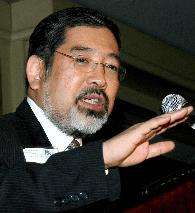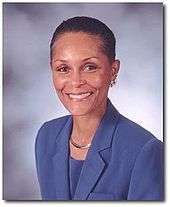Equal Employment Opportunity Commission
 | |
| Agency overview | |
|---|---|
| Formed | July 2, 1965 |
| Headquarters | Washington, D.C. |
| Employees | 2,539 (March 2011)[1] |
| Annual budget | $344 million (2009)[2] |
| Agency executives |
|
| Website | www.eeoc.gov |
The U.S. Equal Employment Opportunity Commission (EEOC) is a federal agency that administers and enforces civil rights laws against workplace discrimination. The EEOC investigates discrimination complaints based on an individual's race, children, national origin, religion, sex, age, disability, gender identity, genetic information, and retaliation for reporting, participating in, and/or opposing a discriminatory practice.[3]
History
On March 6, 1961, President John F. Kennedy signed Executive Order 10925, which required government contractors to "take affirmative action to ensure that applicants are employed and that employees are treated during employment without regard to their race, creed, color, or national origin."[4] It established the President's Committee on Equal Employment Opportunity of which then Vice President Lyndon Johnson was appointed to head. This was the forerunner of the EEOC.
The EEOC was established on July 2, 1965; its mandate is specified under Title VII of the Civil Rights Act of 1964, the Age Discrimination in Employment Act of 1967 (ADEA),[5] the Rehabilitation Act of 1973, the Americans with Disabilities Act (ADA) of 1990, and the ADA Amendments Act of 2008. The EEOC's first complainants were female flight attendants.[6] However, the EEOC at first ignored sex discrimination complaints, and the prohibition against sex discrimination in employment went unenforced for the next few years.[7] One EEOC director called the prohibition "a fluke... conceived out of wedlock." [7]
All Commission seats and the post of general counsel to the commission are filled by the US President, subject to confirmation by the Senate.[8] Stuart J. Ishimaru, a Commissioner who was confirmed in 2003 and 2006,[9] served as Acting Chair of the Commission from January 20, 2009 until December 22, 2010, when the Senate confirmed Jacqueline Berrien to be the chairwoman. She had been nominated as chairwoman by President Barack Obama in July 2009.[10] In September 2009, Obama chose Chai Feldblum to fill another vacant seat.[11]
On March 27, 2010, Obama made recess appointments of three Commission posts: Berrien, Feldblum, and Victoria Lipnic. With the appointments, the Commission had its full five Commissioners: Ishimaru, Berrien, Feldblum, Lipnic, and Constance Barker, who was confirmed by the Senate in 2008 to be a Commissioner. Obama also made a recess appointment of P. David Lopez to be the EEOC's General Counsel.[12]
On December 22, 2010, the Senate gave full confirmation to Berrien, Feldblum, Lipnic, and Lopez.
In 2011, the Commission included "sex-stereotyping" of lesbian, gay, and bisexual individuals, as a form of sex discrimination illegal under Title VII of the Civil Rights Act of 1964.[13][14] In 2012, the Commission expanded protection provided by Title VII to transgender status and gender identity.[13][15]
After the departure of Ishimaru, the commission returned to its full five commissioners on April 25, 2013, with the Senate confirmation of Jenny Yang.
In 2015, it concluded that for Title VII, sex discrimination includes discrimation based on sexual orientation.[16][17]
However, the rulings, while persuasive, are not binding on courts and would need to be addressed by the Supreme Court for a final decision. The Commission also mediates and settles thousands of discrimination complaints each year prior to their investigation. The EEOC is also empowered to file civil discrimination suits against employers on behalf of alleged victims and to adjudicate claims of discrimination brought against federal agencies.[18][19]
Problems with punitive discrimination remedies in the workplace
The EEOC's current punitive remedies evolved largely from the Supreme Court's decision in Smith v. Wade in which the Court allowed the award of punitive damages under 42 U.S.C. § 1983 only when the employer's conduct was shown to be "motivated by evil motive or intent, or when it involve[d] reckless or callous indifference to the federally protected rights of others." In 1999, the Supreme Court went on to refine (in Kolstad v. American Dental Association) essentially that punitive protections look to how "greatly" an employer knows they are ignoring civil rights laws much more than the nature of the particular law they ignore: "not to the employer's awareness that it is engaging in discrimination, but to its knowledge that it may be acting in violation of federal law...."
In 1991, Congress set the original limits on the amount of discrimination damages that a person can recover from their employer,[20] which vary depending on how many people are employed by a particular employer. As of February 20, 2016, the maximum monetary limit for the largest employers still stood at its 1991 initial value of $300,000, despite the fact that the Federal Penalties Inflation Adjustment Act of 1990 (Public Law 101-410) would allow for at least an 175% increase (based on changes in the consumer price index between the two periods) to $525,000. The Debt Collection Improvement Act of 1996 amended the Federal Civil Penalties Inflation Adjustment Act of 1990 to require every federal agency to enact regulations that adjust each Civil Monetary Penalty provided by law under its jurisdiction by the rate of inflation at least once every four years. In 2014, the EEOC raised the fines for "failure to post proper signage" from $110 to $210, in two stages, once in or before 2009, by the 10% statutory limit on initial raises (to $110), and again no less than five years, later to an amount more consistent with the consumer price index or a lesser need.
In an opinion handed down in December 2014 in the matter of Aguilar v. ASARCO LLC, CV 08-441-TUC-MWB, the United States Court of Appeals for the Ninth Circuit noted en banc (generally meaning the full court rather than just a few judges of the court), "The $300,000 dollar amount of the cap provides an extremely limited potential for recovery, and has not been changed, nor been adjusted for inflation, since its adoption in 1991." Asarco appealed to the 9th Circuit Court after a jury in the United States District Court for the District of Arizona originally punitively awarded Aguilar $868,750, and District Judge Mark W. Bennett reduced the amount to the statutory cap of $300,000. Asarco lost its appeal to have the amount reduced more.
Some concerns regarding how inflation erodes non-adjusted statutory caps are difficult to address but can include at least the implications to those seeking relief under the Due Process Clause of the Fifth Amendment, consideration of if paying a fine becomes more cost-effective than following the law (under the Equal Protection Clause of the Fourteenth Amendment), and if a federal statutory cap may be obstructing any particular state from instituting more appropriate deterrents for the benefit of enterprises within a state. Aggravating the problem of an agency's statutory cap starting behind the CPI curve is that an initial increase cannot be for more than 10% of an original Congressional cap. If the EEOC acted tomorrow, the statutory cap cannot legally be raised to more that $330,000 or raised again after that for five more years without Congressional action because of in the Debt Collection Improvement Act of 1996.
Another less obvious reality about the current EEOC statutory caps that Aguilar v. ASARCO LLC raises is that: while the damages to the plaintiff amounted to the statutory cap of $300,000... the legal fees awarded to Aguilar's attorneys were more than $350,000. In Riverside v. Rivera (1986), the Supreme Court found that it is proper to look beyond monetary fee ratios in civil rights cases because the general population benefits when a plaintiff benefits in a civil rights matter; that although the legal fees can be expressed in terms of money, no proper ratio for fees to award can be developed because the non-monetary positive outcomes of a civil rights victory are shared among so many.
Staffing, workload, and backlog
In 1975, when the backlog reached more than 100,000 charges to be investigated, President Gerald Ford's full requested budget of $62 million was approved. A "Backlog Unit" was created in Philadelphia in 1978 to resolve the thousands of federal equal employment complaints inherited from the Civil Service Commission. In 1980, Eleanor Holmes Norton began re-characterizing the backlog cases as "workload" in her reports to Congress, thus fulfilling her promise to eliminate the backlog.[21]
In June 2006, civil rights and labor union advocates publicly complained that the effectiveness of the EEOC was being undermined by budget and staff cuts and the outsourcing of complaint screening to a private contractor whose workers were poorly trained. In 2006, a partial budget freeze prevented the agency from filling vacant jobs, and its staff had shrunk by nearly 20 percent from 2001. A Bush administration official stated that the cuts had been made because it was necessary to direct more money to defense and homeland security.[22] By 2008, the EEOC had lost 25 percent of its staff over the previous eight years, including investigators and lawyers who handle the cases. The number of complaints to investigate grew to 95,400 in fiscal 2008, up 26 percent from 2006.[23]
Although full-time staffing of the EEOC was cut between 2002 and 2006, Congress increased the commission's budget during that period, as it has almost every year since 1980. The budget was $303 million in fiscal year 2001[2] to $327 million in fiscal year 2006.[23]
The outsourcing to Pearson Government Solutions in Kansas cost the agency $4.9 million and was called a "huge waste of money" by the president of the EEOC employees' union in 2006.[22]
The EEOC uses punitive monetary fines as their primary form of deterrence; it is likely that because the EEOC has not adjusted a great many of their fines for inflation, the backlog of EEOC cases illustrates eroding deterrence.
Race and ethnicity
The EEOC requires employers to report various information about their employees, in particular their racial/ethnic categories, to prevent discrimination based on race/ethnicity. The definitions used in the report have been different at different times.
In 1997, the Office of Management and Budget gave a Federal Register Notice, the "Revisions to the Standards for the Classification of Federal Data on Race and Ethnicity," which defined new racial and ethnic definitions.[24] As of September 30, 2007, the EEO's EEO-1 report must use the new racial and ethnic definitions in establishing grounds for racial or ethnic discrimination.[25] If an employee identifies their ethnicity as "Hispanic or Latino" as well as a race, the race is not reported in EEO-1, but it is kept as part of the employment record.
A person's color or physical appearance can be grounds for a case of racial discrimination as well.[26] Discrimination based on national origin can be grounds for a case on discrimination as well.[27]
Investigative compliance policy
EEOC applies an investigative compliance policy when respondents are unco-operative in providing information during an investigation of a charge. If a respondent fails to turn over requested information, field offices are to subpoena the information, file a direct suit on the merits of a charge, or use the legal principle of adverse inference, which assumes the withheld information is against the respondent.[28]
Increase in disability-based charges
In 2008, disability-based charges handled by the EEOC rose to a record 19,543, up 10.2 percent from the prior year and the highest level since 1995.[29]
That may again be showing that because the EEOC has not adjusted many of their initial 1991 fines for inflation, the backlog of EEOC cases illustrates erosion of deterrence.
Home Depot disability discrimination suit
In September 2012, Home Depot agreed to pay $100,000 and furnish other relief to settle a disability discrimination lawsuit filed by the EEOC for the alleged failure to provide reasonable accommodation for a cashier with cancer at its Towson, Maryland, store and for later purportedly firing her because of her condition.[30]
2012 profile
The U.S. Equal Employment Opportunity Commission (EEOC) announced that it received 99,412 private sector workplace discrimination charges during fiscal year 2012, down slightly from the previous year. The year-end data also show that retaliation (37,836), race (33,512), and sex discrimination (30,356), which includes allegations of sexual harassment and pregnancy were the most frequently filed charges.[31]
Additionally, the EEOC achieved a second consecutive year of a significant reduction in the charge inventory, something not seen since fiscal year 2002. Due to a concerted effort, the EEOC reduced the pending inventory of private sector charges by 10 percent from fiscal year 2011, bringing the inventory level to 70,312. This inventory reduction is the second consecutive decrease of almost ten percent in charge inventory. Also this fiscal year, the agency obtained the largest amount of monetary recovery from private sector and state and local government employers through its administrative process — $365.4 million.
In fiscal year 2012, the EEOC filed 122 lawsuits, including 86 individual suits, 26 multiple-victim suits, with fewer than 20 victims, and 10 systemic suits. The EEOC's legal staff resolved 254 lawsuits for a total monetary recovery of $44.2 million.
EEOC also continued its emphasis on eliminating alleged systemic patterns of discrimination in the workplace. In fiscal year 2012, EEOC completed 240 systemic investigations which in part resulted in 46 settlements or conciliation agreements. These settlements, achieved without litigation, secured 36.2 million dollars for the victims of unlawful discrimination. In addition, the agency filed 12 systemic lawsuits in fiscal year 2012.
Overall, the agency secured both monetary and non-monetary benefits for more than 23,446 people through administrative enforcement activities – mediation, settlements, conciliations, and withdrawals with benefits. The number of charges resolved through successful conciliation, the last step in the EEOC administrative process prior to litigation, increased by 18 percent over 2011.
Criticism
Some employment-law professionals criticized the agency after it issued advice that requiring a high school diploma from job applicants could violate the Americans with Disabilities Act. The advice letter stated that the longtime lowest common denominator of employee screening must be "job-related for the position in question and consistent with business necessity." A Ballard Spahr lawyer suggested, "There will be less incentive for the general public to obtain a high school diploma if many employers eliminate that requirement for job applicants in their workplace."[32]
The EEOC has been criticized for alleged heavy-handed tactics in their 1980 lawsuit against retailer Sears, Roebuck & Co. Based on a statistical analysis of personnel and promotions, EEOC argued that Sears both was systematically excluding women from high-earning positions in commission sales and was paying female management lower wages than male management. Sears, represented by lawyer Charles Morgan, Jr., counter-argued that the company had encouraged female applicants for sales and management, but women preferred lower-paying positions with more stable daytime working hours, as compared to commission sales, which demanded evening and weekend shifts and featured drastically-varying paychecks, depending on the numbers of sales in a given pay period. In 1986, the court ruled in favor of Sears on all counts and noted that the EEOC had neither produced a single witness who alleged discrimination nor identified any Sears policy that discriminated against women.[33][34]
In a 2011 ruling against the EEOC, Judge Loretta A. Preska declared that It relied too heavily on anecdotal claims rather than on hard data, in a lawsuit against Bloomberg, L.P. that alleged discrimination against pregnant employees. In a ruling described in the New York Times[35] as "strongly worded," Preska wrote, "the law does not mandate 'work-life balance'l and added that while Bloomberg had expected high levels of dedication from employees, the company did not treat women who took pregnancy leave differently from those who took leave for other reasons.
Commissioners
- Luther Holcomb, 1965–1974
- Aileen Hernandez, 1965–1966
- Vicente T. Ximenes, 1967–1971
- Samuel C. Jackson, 1965–1968
- Richard Graham, 1965–1966
- Elizabeth Kuck, 1968–1970
- Ethel B. Walsh, 1971–1980
- Colston A. Lewis, 1970–1977
- Raymond L. Telles, 1971–1976
- J. Clay Smith, 1978–1982
- Hon. Daniel Leach, 1976–1981
- Armando Rodriguez, 1978–1983
- Cathie Shattuck, 1982–1983
- Tony E. Gallegos, 1982–1994
- R. Gaull Silberman, 1984–1995
- Joy Cherian, 1987–1993
- William Webb, 1982–1986
- Fred Alvarez, 1984–1987
- Evan J. Kemp, Jr., 1987–1993
- Joyce Tucker, 1990–1996
- Paul Steven Miller, 1994–2004
- Reginald E. Jones, 1996–2000
Chairs
| No. | Chair of the EEOC | Picture | Start of Term | End of Term | President(s) |
|---|---|---|---|---|---|
| 1 | Franklin D. Roosevelt Jr. |  |
May 26, 1965 | May 11, 1966 | Lyndon Johnson |
| 2 | Stephen N. Shulman |  |
September 14, 1966 | July 1, 1967 | |
| 3 | Clifford Alexander Jr. |  |
August 4, 1967 | May 1, 1969 | |
| 4 | William H. Brown III |  |
May 5, 1969 | December 23, 1973 | Richard Nixon |
| 5 | John H. Powell Jr. |  |
December 28, 1973 | March 18, 1975 | |
| Acting | Ethel Bent Walsh | 1975 | Gerald Ford | ||
| 6 | Lowell W. Perry |  |
May 27, 1975 | May 15, 1976 | |
| Acting | Ethel Bent Walsh | May 1976 | May 1977 | ||
| 7 | Eleanor Holmes Norton |  |
May 27, 1977 | February 21, 1981 | Jimmy Carter |
| Acting | J. Clay Smith Jr. | 1981 | 1982 | Ronald Reagan | |
| 8 | Clarence Thomas |  |
May 6, 1982 | March 8, 1990 | |
| 9 | Evan J. Kemp Jr. |  |
March 8, 1990 | April 2, 1993 | Ronald Reagan George H. W. Bush |
| Acting | Tony Gallegos | 1993 | 1994 | Bill Clinton | |
| 10 | Gilbert Casellas |  |
September 29, 1994 | December 31, 1997 | |
| Acting | Paul Igasaki |  |
1998 | ||
| 11 | Ida L. Castro |  |
October 23, 1998 | August 13, 2001 | |
| 12 | Cari M. Dominguez |  |
August 6, 2001 | August 31, 2006 | George W. Bush |
| 13 | Naomi C. Earp |  |
September 1, 2006 | 2009 | |
| Acting | Stuart J. Ishimaru | |
January 20, 2009 | April 7, 2010 | Barack Obama |
| 14 | Jacqueline A. Berrien | April 7, 2010[36] | September 2, 2014 | ||
| 15 | Jenny R. Yang |  |
September 2, 2014[37] | January 22, 2017 | |
| Acting | Victoria A Lipnic |  |
January 25, 2017[38] | present | Donald Trump |
See also
- ADA Amendments Act of 2008 (ADAAA)
- Equal Pay Act of 1963
- Title 29 of the Code of Federal Regulations
- Pregnancy discrimination
- Race and ethnicity (EEO)
- Title VII Civil Rights Act of 1964
- Katherine Pollak Ellickson
References
- ↑ FedScope
- 1 2 "EEOC Budget and Staffing History". Archives. EEOC.gov. May 12, 2009.
- ↑ "Types of Discrimination".
- ↑ wikisource – Executive Order No. 10925
- ↑ 29 U.S.C. 621 et seq., as amended
- ↑ Gail Collins (14 October 2009). When Everything Changed: The Amazing Journey of American Women from 1960 to the Present. Little, Brown. pp. 59–. ISBN 978-0-316-07166-6.
- 1 2 The will of the people: how public ... – Google Books. Books.google.com. September 29, 2009. ISBN 9780374220341. Retrieved June 29, 2011.
- ↑ "42 U.S.C. § 2000e-4 – Equal Employment Opportunity Commission".
- ↑ "Nominations PN845-110 and PN1029-108". Thomas (Library of Congress). Retrieved February 2, 2010.
- ↑ Press Office (July 16, 2009). "President Obama Announces Pick to Head Equal Employment Opportunity Commission".
- ↑ Press Office (September 14, 2009). "President Obama Announces More Key Administration Posts".
- ↑ "President Obama Announces Recess Appointments to Key Administration Positions | The White House". Whitehouse.gov. 2010-03-27. Retrieved 2013-10-06.
- 1 2 "Discrimination Based on Sexual Orientation, Status as a Parent, Marital Status and Political Affiliation". Retrieved February 18, 2013.
- ↑ "EEOC Request No. 0520110649". Retrieved February 18, 2013.
- ↑ "Macy v. Department of Justice, EEOC Appeal No. 0120120821". Retrieved February 28, 2013.
- ↑ Carpenter, Dale (2012-12-14). "Anti-gay discrimination is sex discrimination, says the EEOC". The Washington Post. Retrieved 2015-07-17.
- ↑ Tatectate, Curtis. "EEOC: Federal law bans workplace bias against gays, lesbians, bisexuals | Miami Herald Miami Herald". Miamiherald.com. Retrieved 2015-07-17.
- ↑ See "42 U.S.C. § 2000e-2 – Unlawful Employment Practices". and "42 U.S.C. § 2000e-3 – Other Unlawful Practices".
- ↑ In addition, the EEOC, the Departments of Labor and Justice, the Civil Service Commission and the Office of Revenue Sharing have adopted Uniform Guidelines on Employee Selection Procedures to assist employers in complying with federal laws prohibiting employment discrimination."Uniform Guidelines On Employee Selection Procedures". Retrieved February 2, 2010.
- ↑ limits on the amount of discrimination damages that a person can recover from their employer
- ↑ "Enforcing the Civil Rights Act: Fighting Racism, Sexism and the Ku Klux Klan. The Story of the Miami EEOC's First Class Action Trial." James Keeney, 2012 Civil Rights Publishing, Sarasota, FL
- 1 2 Lee, Christopher (June 14, 2006). "EEOC Is Hobbled, Groups Contend: Case Backlog Grows as Its Staff Is Slashed, Critics Say". Washington Post.
- 1 2 Vogel, Steve (March 31, 2009). "EEOC Willfully Violated Pay Law, Arbitrator Rules". Washington Post. p. A15.
- ↑ "Revisions to the Standards for the Classification of Federal Data on Race and Ethnicity"
- ↑ Final Revisions of the Employer Information Report (EEO-1) Archived August 13, 2009, at the Wayback Machine. by the EEOC. The page contains links to FAQs, forms and instructions
- ↑ The US Equal Employment Opportunity Commission. "Race/Color Discrimination." August 15, 2007. "We may use this for the purpose of race and ethnicity."
- ↑ The US Equal Employment Opportunity Commission. "National Origin Discrimination." August 15, 2007.
- ↑ AAjing
- ↑ "Ability Magazine: BAD BOYS – EEOC Tackles Job Discrimination" (2009)". Retrieved 2012-04-05.
- ↑ "Home Depot to Pay $100,000 to Settle EEOC Disability Discrimination Suit". The National Law Review. U.S Equal Employment Opportunity Commission. 2012-09-10. Retrieved September 23, 2012.
- ↑ "Enforcement and Litigation Statistics". Retrieved 2013-01-30.
- ↑ Dave Boyer (1 January 2012). "EEOC: High school diploma requirement might violate Americans with Disabilities Act". Washington Times.
- ↑ EEOC v. Sears, Roebuck & Co., 628 F. Supp. 1264 (N.D. Ill. 1986) (Sears II).
- ↑ Possley, Maurice (1986). Sears Wins 12-year Fight Over Bias Chicago Tribune 4 February 1986. Retrieved 2012-12-10.
- ↑ https://www.nytimes.com/2011/08/18/nyregion/discrimination-suit-against-bloomberg-lp-is-dismissed.html?_r=2&ref=equalemploymentopportunitycommission
- ↑ "Jacqueline A. Berrien Becomes Chair of the Equal Employment Opportunity Commission". U.S. Senate Equal Employment Opportunity Commission. 2010-04-07. Retrieved 2010-11-16.
- ↑ "President Appoints Jenny R. Yang EEOC Chair". Equal Employment Opportunity Commission. Retrieved 2014-09-19.
- ↑ "Victoria A. Lipnic, Acting Chair". www.eeoc.gov. Retrieved 2017-08-02.
External links
| Wikimedia Commons has media related to Equal Employment Opportunity Commission. |
- Official website
- Proposed and finalized federal regulations from the Equal Employment Opportunity Commission
- Role of Equal employment opportunity commission
- Records of the Equal Employment Opportunity Commission in the National Archives (Record Group 403)
- nytimes.com, discusses the fairly recent case involving allegations against Bloomberg unfairly treating pregnant women. Bloomberg won because of a lack of statistics on the Equal Employment Opportunity Commission's part. However, it is still possible for the federal government to appeal and the witnesses can individually sue Bloomberg for discrimination.
- https://en.wikisource.org/wiki/Federal_Civil_Penalties_Inflation_Adjustment_Act_of_1990